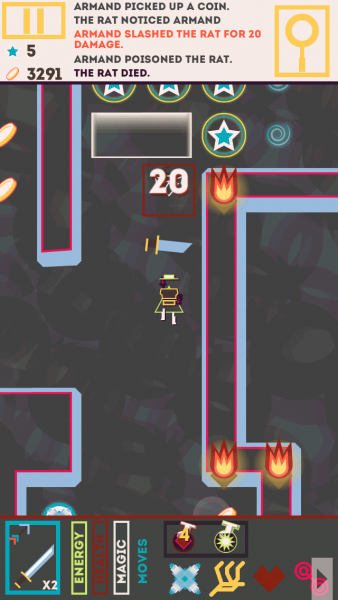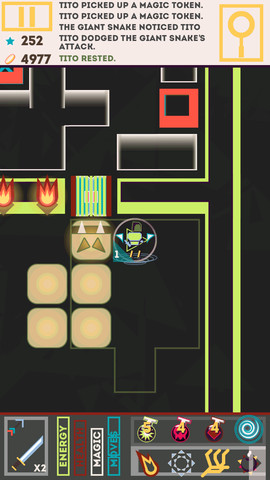Does anyone reading this article happen to remember an ancient game that used to be popular – particularly around the time of the Commodore 64 – known as Temple of Apshai? Those who not only said yes – but also still have fond memories of the title – might happen to be rather interested in Jeffrey Fal’s recent release of Dungeonism (out now, $1.99). Everyone else might want to carefully read this review before they decide whether or not to take a trip down memory lane, for this game is most certainly not pulling any of its punches.
 Okay – first things first – has anyone here ever heard of the gaming genre known as Roguelike before, or perhaps even played any modern examples of this videogame subset? It is – basically – a field of game design entirely based around randomly generated stages, generally with no assurance being given that anything taking place will be fair and/or consistent. While you could be given a situation where no amount of skill would ever imaginably see you triumph, you could just as easily be given an arrangement of elements leading to a veritable cakewalk.
Okay – first things first – has anyone here ever heard of the gaming genre known as Roguelike before, or perhaps even played any modern examples of this videogame subset? It is – basically – a field of game design entirely based around randomly generated stages, generally with no assurance being given that anything taking place will be fair and/or consistent. While you could be given a situation where no amount of skill would ever imaginably see you triumph, you could just as easily be given an arrangement of elements leading to a veritable cakewalk.
For those of you who have never played Temple of Apshai before, it was a top down perspective based dungeon exploration game with an extremely minimalist graphical presentation. You would slowly explore a dungeon one room and/or hallway at a time, collecting every last piece of treasure you could find, all while killing everything you came up against with either swords or arrows. Over time you would increase your hero’s abilities by spending their amassed experience, enabling them to successfully explore ever deeper with each return trip they made to the game’s ruins.
While the original Temple of Apshai itself featured completely fixed levels that never shifted, Dungeonism is what it might have been had the classic title featured a degree of randomization. What you encounter in each level of Jeffrey Fal’s throwback – however -can’t happen completely at random, you won’t ever run into something like an endgame monster during an early dungeon tier. While the kinds of things you can encounter in each dungeon section can only come from a fixed list, the amount of each you’ll run into – as well as the layout of the floor plan – will be different each and every time.
 Dungeonism keeps its control scheme rather simple, with virtually every command imaginable – chiefly: movements and attacks – being controlled entirely via an interface of nothing but single taps. As this game is turn based – rather than real time like its joystick operated inspirational source was – the interface works out really well, especially since no action is locked in until you lift up your finger. If no enemies are around you can move about however much you wish freely, when the opposition is present you may move/attack an amount permitted by your stats before it becomes their turn.
Dungeonism keeps its control scheme rather simple, with virtually every command imaginable – chiefly: movements and attacks – being controlled entirely via an interface of nothing but single taps. As this game is turn based – rather than real time like its joystick operated inspirational source was – the interface works out really well, especially since no action is locked in until you lift up your finger. If no enemies are around you can move about however much you wish freely, when the opposition is present you may move/attack an amount permitted by your stats before it becomes their turn.
Whenever you attack with a sword the most important thing is the direction enemies are facing when you strike, as they can only defend against damage – and/or status effects – that come from their front. Of course, it’s also important to keep in mind where you’ll be facing at the end of your turn – and what you might get knocked into – as the same rules apply when it becomes the enemies’ turn. Arrows – on the other hand – can be fired from pretty much anywhere and are never blockable, the chief caveats being that they are much weaker and have a finite supply available.
If it wasn’t clear from what I said earlier, I want to take a moment now to reiterate that Dungeonism is generally a very difficult – and sometimes straight up impossible – game to tackle. Usually it will take a lot of care – as well as learning through failure – to be able to successfully pass any of the title’s stages, and that’s assuming it doesn’t arrange things in such a way that you had no hope but to be simultaneously ravaged from all sides. However, this level of challenge – with its extreme emphasis on a total lack of hand holding – is what the many fans of the Roguelike genre have come to both expect and appreciate.
 The only downside is that occasionally Dungeonism’s random level generation can create an impossible situation of a totally different variety than what the Roguelike fans tend to enjoy. Once while playing the game I had to abort a run – of which I was otherwise winning – because the sturdy block I needed to push forward was unmovable thanks to the enemy that had been spawned directly behind it, creating a categorically impossible scenario of an entirely different flavor. Therefore those looking to play Dungeonism should be warned that – although somewhat rare – there is a change of the world gen creating an unsolvable puzzle, but hopefully future updates should rectify this.
The only downside is that occasionally Dungeonism’s random level generation can create an impossible situation of a totally different variety than what the Roguelike fans tend to enjoy. Once while playing the game I had to abort a run – of which I was otherwise winning – because the sturdy block I needed to push forward was unmovable thanks to the enemy that had been spawned directly behind it, creating a categorically impossible scenario of an entirely different flavor. Therefore those looking to play Dungeonism should be warned that – although somewhat rare – there is a change of the world gen creating an unsolvable puzzle, but hopefully future updates should rectify this.
Anyways, with my discussion of how Dungeonism works now out of the way, I would like to close by covering this title’s unique take on how to pay tribute to Temple of Apshai’s visual style. That ancient computer game – from which Jeffrey Fal’s Roguelike takes much of its inspiration – featured an extremely sparse pixel art presentation, where the visuals were more meant to be icons standing in for things than a depiction of how the locations might have actually looked. While Dungeonism itself does not use a single ounce of pixel art, it does employ a stylish minimalist presentation – comprised of stand-in icons – that does a good job of updating the appearance of what is being homaged.
iFanzine’s Verdict: Dungeonism is a stylishly presented neo-retro tribute to the ancient PC RPG classic: Temple of Apshai, but with a twist thrown in by taking a page from the Roguelike genre. While keeping the controls simple, the game will still demand much care and thought – as befitting what fans everywhere expect of proper Roguelike gameplay – and is therefore only for people seeking an extreme challenge. Unfortunately there is currently a tiny chance of Dungeonism randomly generating a level where enemy placement causes a sliding block segment to become impossible to succeed at, an issue that will hopefully be rectified in a future update.


